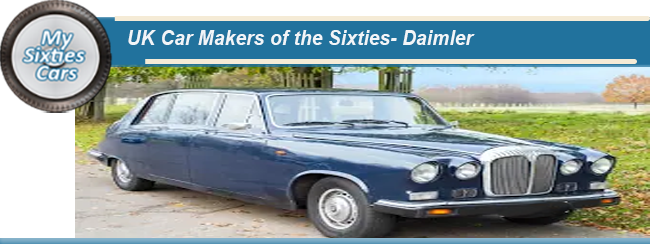
Formed as an independent motorcycle manufacturer in the early nineteen hundreds, Daimler, like so many other small companies trying to make their mark in the early days of motorised transport, found it challenging to finance their operations.
 Facing imminent and ignominious closure, Daimler allowed themselves to be taken over by the much larger BSA company in 1910.
Facing imminent and ignominious closure, Daimler allowed themselves to be taken over by the much larger BSA company in 1910.
BSA provided Daimler with the fiscal stability and management ability to allow the company to develop, and they soon turned all of their attention to manufacturing motor vehicles.
During the Twenties and Thirties, a series of magnificent machines ensured Royal Family patronage, and the company produced a range of graceful and dignified middle-class vehicles.
By the end of the Thirties, Daimler Motors was one of the most prestigious British car-makers. initially building German cars under licence.
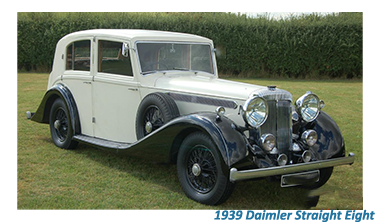 In the Fifties, under Sir Bernard Docker's chairmanship (with his notorious and extravagant wife, Lady Norah Docker taking a very active part in the running of the company), Daimler's image became steadily tarnished.
In the Fifties, under Sir Bernard Docker's chairmanship (with his notorious and extravagant wife, Lady Norah Docker taking a very active part in the running of the company), Daimler's image became steadily tarnished.
With the Daimler company gradually becoming a laughing stock, shareholder intervention looked almost inevitable.
The shareholder revolt, when it came, was led by Jack Sangster.
Sangster had joined the board of Daimler in 1951 after selling the Ariel and Triumph motorcycle companies that he owned to BSA.
From day one, Sangster began to press Sir Bernard to make changes in the company, although it took him five years for the change in management to happen.
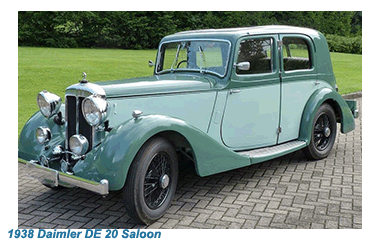 When the change eventually did take place, in 1956, Sangster was voted in as the new Chairman, with his first step was to promote the talented Edward Turner to head Daimler’s entire automotive division.
When the change eventually did take place, in 1956, Sangster was voted in as the new Chairman, with his first step was to promote the talented Edward Turner to head Daimler’s entire automotive division.
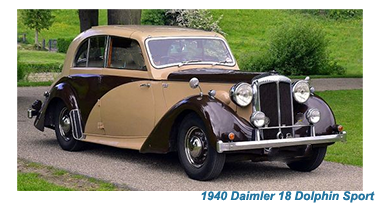 During his spell at the helm, Turner was responsible for the launch of the Daimler SP250 and Majestic Major models.
During his spell at the helm, Turner was responsible for the launch of the Daimler SP250 and Majestic Major models.
Under Sangster’s management, Daimler’s fortunes took a definite turn for the better, strong enough to become attractive to Billy Lyon at Jaguar.
Lyon made no secret of the fact that he was much more in need of factory space and production capabilities than Daimler’s range of slightly jaded models.
Sir William Lyons, Jaguar's firebrand founder and managing directors, went through Daimler like the proverbial " new broom"."
![]()
In little time the business was revived, and Daimler-badged Jaguars began to sell steadily throughout the Sixties.
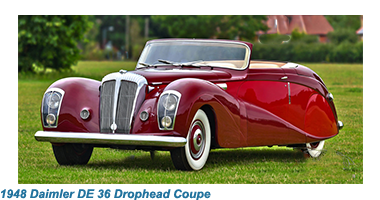 The SP250 Dart was shown in prototype form at the New York Motor Show that April, based on a short, strongly cross-braced chassis frame with a wheelbase of only 7 feet 8 inches, and which passed below the live rear axle.
The SP250 Dart was shown in prototype form at the New York Motor Show that April, based on a short, strongly cross-braced chassis frame with a wheelbase of only 7 feet 8 inches, and which passed below the live rear axle.
Powered by a well-designed and engineered V8 engine Light alloy cylinder heads were used with a compression ratio of only 8.2:1, and the 2500-cc unit produced a genuine 140 bhp at 5,800 rpm.
The Dart came with a glass-fibre body, with a high domed bonnet blending in with short bulbous wings and thrusting forward ahead of them into a protruding air intake, carrying a low and wide representation of the classic fluted Daimler grille.
 Two wide-opening doors were used and the rear wings swept up into prominent fins with a roomy boot accessible through a large squared-off hinged lid wrapping over the tail transom.
Two wide-opening doors were used and the rear wings swept up into prominent fins with a roomy boot accessible through a large squared-off hinged lid wrapping over the tail transom.
Accommodation included comfortable and well-wrapped-round front bucket seats with fairly limited leg-room and a small occasional bench seat in the rear of the cockpit for children or the usual 'transverse adult'.
Soft and hard-tops were available, and this lightweight machine could reach a top speed of 120 mph, and the smooth and quiet V8 accelerated the vehicle from 0-60 mph in around nine seconds.
Sangster's second brainchild, running concurrently with the Dart was the Majestic saloon, a full-sized family saloon. Smooth and quiet in true Daimler tradition and matched the stylish four-door saloon body very well in terms of refinement and finish.
Powered by a six-cylinder 3794-cc engine producing 147 bhp, with power boosted by . twin SU HD6 carburettors.
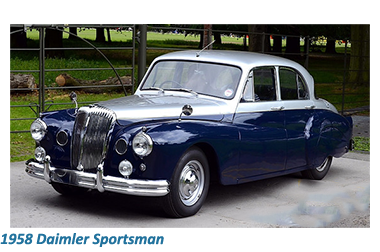 Generally similar but newly released at the 1959 London Show was the Majestic Major saloon, incorporating various improvements and using a new 44-litre version of the SP250 sports model's V8 engine, providing a capacity of 4561cc.
Generally similar but newly released at the 1959 London Show was the Majestic Major saloon, incorporating various improvements and using a new 44-litre version of the SP250 sports model's V8 engine, providing a capacity of 4561cc.
The car's boot was extended by some 6 inches, and internally a new fascia was adopted.
In September 1961 a new eight-seater Limousine model, the DR450 was released, using the 4561-cc V8 engine from the Majestic Major in a similarly styled but very much enlarged version of the same shell.
A sliding glass partition divided chauffeur from passengers, and luxury trim, twin heating systems and power steering were all fitted as standard.
![]()
With the Jaguar-Daimler merger of 1960, the appearance of a combination model was only a matter of time.
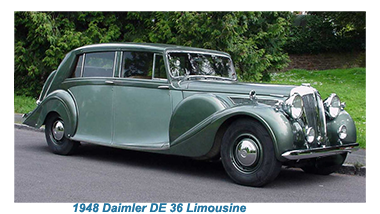 In October 1962 the resultant model appeared, Sir William Lyons having characteristically combined the best that both concerns had to offer in an aesthetically attractive and sophisticated model, the Daimler 2-litre saloon.
In October 1962 the resultant model appeared, Sir William Lyons having characteristically combined the best that both concerns had to offer in an aesthetically attractive and sophisticated model, the Daimler 2-litre saloon.
Internally the new Daimler was similarly trimmed and comfortably appointed to the standard Mark II Jaguar range, which always offered extraordinary value for money, although a split front bench seat was new, offering individual adjustment for two occupants, or full-width comfort for three.
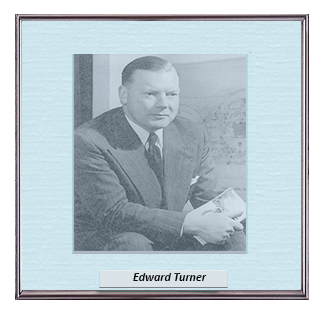 With some of their early models looking jaded, in August 1966, announced the arrival of the 4235-cc six-cylinder-engined Daimler Sovereign.
With some of their early models looking jaded, in August 1966, announced the arrival of the 4235-cc six-cylinder-engined Daimler Sovereign.
The new car used the Jaguar `S' type shell with its nose modified to fit the fluted Daimler radiator, offset with four headlamps with separate sidelights and wraparound indicators, and rectangular air intakes on either side of the grille base.
Powered by a 4.2-litre XK Jaguar engine, mated to either the new all-synchro Jaguar gearbox with overdrive or a Borg-Warner Model 8 with dual drive range.
Fitted with independent all-round suspension and four wheel discs the Daimler Sovereign was an authentic luxury saloon equipped with Varamatic power steering, dual hydraulic braking systems, selective interior car temperature control and alternator as standard.
Other standard features included a pre-engaged starter, heated rear screen, transistorised clock, leather hide upholstery, reclining front seats with centre armrests front and rear, the Sovereign had a fully carpeted boot and twin rear-wing-mounted fuel tanks.
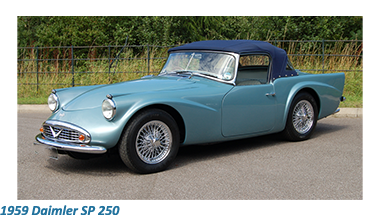 The last Daimler of the Sixties was the DS 420 Limousine, an all-new model with craftsman-built coachwork by Vanden Plas and powered by a six-cylinder 4.2-litre twin Overhead Camshaft engine used in the Jaguar series.
The last Daimler of the Sixties was the DS 420 Limousine, an all-new model with craftsman-built coachwork by Vanden Plas and powered by a six-cylinder 4.2-litre twin Overhead Camshaft engine used in the Jaguar series.
Once again the DS420 enginewas matched up to Borg-Warner Model 8 transmission, with four-wheel disc brakes, power steering, all-independent suspension and extreme luxury as standard.
The launch of the DR 450, the only new Daimler model for 1969, marked the end of a decade of Jaguar development in true Daimler traditions of luxury, comfort and refinement.
Back to the homepage- and don't spare the horsepower.






